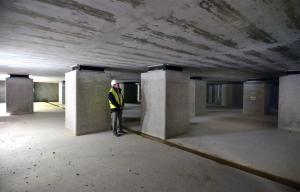Room to move
4 May 2012
In the Jules-Horowitz Research Reactor (RJH) that is being constructed at CEA-Cadarache, the seismic protection system is the same as in ITER: it consists of a first basemat upon which concrete plinths topped by antiseimic pads are installed in order to support a second basemat which bears the weight of the installation.
The RJH reactor and its enclosure being much lighter (100,000 tonnes) than the ITER Tokamak Complex (320,000 tonnes), it requires only 195 seismic pads, as compared to 493 in ITER's case.
Apart from a difference in the number of plinths and pads, and also a slightly higher "ceiling" in RJH (2.20 metres vs 1.90) the ITER and RJH "basements" will be perfectly similar: this picture, taken last week at RJH, could be a picture taken next year in ITER ...


